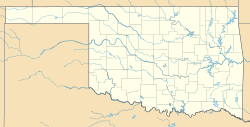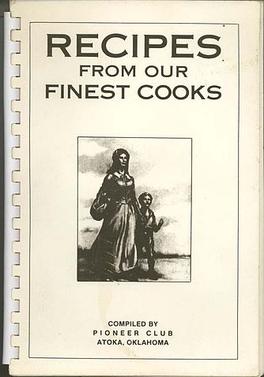Pioneer Woman facts for kids
Quick facts for kids Pioneer Woman |
|
|---|---|
 |
|
| Artist | Bryant Baker |
| Year | 1930 |
| Type | Bronze statue |
| Location | Ponca City, Oklahoma |
|
Pioneer Woman Statue
|
|
| NRHP reference No. | 78002238 |
| Added to NRHP | August 31, 1978 |
The Pioneer Woman monument is a large bronze statue in Ponca City, Oklahoma. It was created by artist Bryant Baker and officially revealed on April 22, 1930. The statue shows a woman wearing a sunbonnet and holding a child's hand. It was a gift to the State of Oklahoma from a rich oilman named E. W. Marland. He wanted to honor the brave women who helped settle the American West.
Marland asked twelve famous sculptors to create small models for the statue. He then sent these models on a tour across the country. People could vote for their favorite design. This helped him decide which model would become the final, huge statue.
Contents
Creating the Pioneer Woman Statue
Around 1925, E. W. Marland had a big idea for many statues. He wanted them to show the story of how the American West was settled. He first talked to a sculptor named Jo Davidson about his plans. Davidson eventually agreed to make three statues for Marland.
While Davidson was working, Marland shared his biggest dream. He wanted a very tall statue, about 25 feet high. This statue would stand on a hill and be seen from far away.
The Statue Models
Marland invited many top American sculptors to join his project. He offered each artist $10,000 to create a small bronze model. These models were about 3 feet tall. Marland planned for the models to travel across the United States. He wanted the public to vote on which one should be built in Ponca City.
Some famous sculptors, like Daniel Chester French and Paul Manship, turned down the offer. Two women artists, Gertrude Vanderbilt Whitney and Anna Hyatt Huntington, also declined. This left Marland with twelve male artists.
The artists who submitted models included Bryant Baker, A. Stirling Calder, Jo Davidson, and James Earle Fraser. Marland suggested a woman in pioneer clothes with a child. He even gave each sculptor a sunbonnet for inspiration. Most of the models showed a woman with a sunbonnet and a child.
Mahonri Young, one of the sculptors, created a detailed model. It showed the pioneer woman holding her child like a mother from a Renaissance painting. He also imagined a large base with scenes of the West. However, the public only saw the small statue, not his full vision.
Bryant Baker, who won the competition, used an actress as his model. This gave his figure a more glamorous look. It represented the idea of a Western hero rather than everyday life.
Donald De Lue, Baker Bryant's main assistant, later shared some details. He said he did much of the work on the competition model in 1927. Baker supervised and finished the face. Baker was also the last sculptor to enter the contest. He had only one month to prepare his model.
James Earle Fraser's model was inspired by his aunt, who was a pioneer. This model was unique because it showed the woman feeding her baby. She also held onto her rifle, showing how pioneer women often did many things at once.
Years later, Wheeler Williams' model was found again. It was made much larger and cast in bronze. Today, it stands in front of the public library in Liberty, Kansas.
The National Tour
The small bronze models were first shown in New York City on February 26, 1927. They stayed there for a few weeks. Marland spoke at a dinner for the artists. He talked about how important pioneer mothers were. He said they carried strength and kindness to the West. He also mentioned how many women faced hardships and died so others could build homes.
Marland had the final say on the statue. But he wanted public opinion. So, the models traveled to museums and art galleries across the country. Stops included Boston, Pittsburgh, Chicago, and Oklahoma City. Finally, they came to Ponca City.
At each place, visitors could vote for their top three favorite models. More than 750,000 people saw the models. Over 120,000 votes were cast.
The models were a big topic of discussion. Newspapers like the New York Times and the LA Times featured photos of them. Art critics shared their opinions. Many thought the sunbonnets were not very artistic. Even elementary school art classes used the models for writing assignments.
On December 20, 1927, Marland's son announced the winner. Bryant Baker's model was chosen. It received the most votes in 11 cities. John Gregory's model was the second most popular.
After the tour, Baker's Pioneer Woman had won first place. It received 42,478 votes, beating John Gregory's 37,782 votes. Donald De Lue then worked on modeling the full-size statue in Baker's studio in 1928 and 1929.
Building the Statue
The entire Pioneer Woman project cost about $350,000. This included $10,000 for each of the twelve artists. The winner, Bryant Baker, received an additional $100,000. The rest of the money covered the national tour and building the statue's base.
Marland paid for most of the project. However, his money was decreasing at the time. So, he needed more help to finish it. Some private donations helped. Lew Wentz, another generous person from Ponca City, also provided $25,000.
Marland bought 2,000 acres of land for the statue. The statue stands about a mile northeast of downtown Ponca City. It is located just off U.S. Route 77.
Bryant Baker said the work was very demanding. He worried he might not live to see it finished.
The Dedication Ceremony
On April 16, 1930, it was announced that the statue would be unveiled. The ceremony took place on April 22, 1930. This date was special because it was the 41st anniversary of the Land Run of 1889. This event opened the Oklahoma Territory to new settlers.
The governor declared the day a state holiday. The celebration in Ponca City included a parade and a 19-gun salute. About 40,000 people came to watch the unveiling.
The dedication started with a radio address from United States President Herbert Hoover. He spoke from the White House. He then introduced Patrick J. Hurley, the Secretary of War. Hurley was from Oklahoma and spoke from his home. The broadcast then continued from Ponca City. Other speakers included Marland, Baker, and Oklahoma Governor William J. Holloway. Famous Oklahoma humorist Will Rogers closed the ceremonies.
President Hoover spoke about the pioneer woman's role. He said they brought kindness, good values, and strength to the West. He noted they worked hard and raised families. They also made sure their children had chances for education and a good life.
Secretary Hurley also praised pioneer women. He said they were not always given enough credit in history. He believed they were essential builders and leaders. He highlighted their intelligence and belief in religion, education, and family.
After the Unveiling
The area around the statue is now called Pioneer Woman State Park. In 2002, the statue was repaired. Workers fixed a crack in the heel of the boy's left boot. This was the first major repair since the artist himself cleaned it years after it was built. Private groups and local organizations helped pay for the repairs. They also funded new lighting and landscaping around the statue.
The Pioneer Woman Museum
On September 16, 1958, the Pioneer Woman Museum opened. This date marked the 65th anniversary of the Land Run of 1893. This land run opened the Cherokee Outlet, which includes Ponca City. The museum is next to the monument. The Pioneer Woman statue is used as the museum's main symbol. In 2016, the museum opened a new entrance and lobby.
Statue Details
Location and Visits
The statue is located in a park that covers about 5.5 acres. It's a peaceful place where visitors can learn about history.
Physical Features
The bronze statue itself is 17 feet tall. It weighs about 12,000 pounds. It stands on a base made of granite blocks. This base makes the total height of the monument 40 feet.
The statue faces southwest. This direction symbolizes that most of the early settlers came from the northeast.
A plaque on the first step of the base reads:
this monument was erected by e. w. marland in appreciation
of the heroic character of the woman who braved the
dangers and endured the hardships incident to the daily
life of the pioneer and homesteader in this country
The Pioneer Woman as a Symbol
The image of the Pioneer Woman has long been a symbol for Ponca City.
In 1941, the General Federation of Women's Clubs gave out special medals. These medals had a small carving of the Pioneer Woman on them. They were given to important members.
The statue is also the official symbol of the Ozark Frontier Trail. This trail covers four states.
When Oklahoma's State Quarter was designed in 2008, many ideas were submitted. Four out of five of the top designs included the Pioneer Woman. However, the final designs sent from the Mint did not show the book under the woman's arm. This caused a debate. People thought it was an attempt to remove an important detail. The artist, Bryant Baker, had said the book represented courage and faith. He explained it was often the only book available for families. Eventually, a different design for the quarter was chosen.
Other Pioneer Woman Art
Several other sculptures have been made that are similar to or inspired by the Pioneer Woman.
The Kansas Pioneer Woman Memorial was planned. Bryant Baker also won this competition. A critic noted how similar his two designs were. However, this Kansas monument was never built. In 1937, a different Kansas Pioneer Memorial by Merrell Gage was unveiled.
In 1959, a 36-foot-tall fiberglass sculpture was made for the Minnesota State Fair. It stands in front of the Pioneer Building. Like the Ponca City statue, it shows a woman in a bonnet walking forward. She also holds a large book and a bundle.
Hardship and Dreams is a sculpture by Dorothy Koelling. It was revealed in Wichita, Kansas, in 1994. A newspaper said it was "inspired by the monumental 'Pioneer Woman' in Ponca City, Okla." Koelling's six-foot-tall statue shows a pioneer woman holding a book and a bundle. She walks forward with her son, whose hand she holds.
See also





